Text
Cyberpunk for the 21st Century: ONF’s “Sukhumvit Swimming”
If I write about a K-pop group, chances are I have been a fan of them for a while. This is not the case for ONF. M-Net’s Road to Kingdom brought this group to my attention, and though I checked out some of their work it is the sextet’s latest comeback, Spin-Off, hooked me to them. The title track for this mini album is “Sukhumvit Swimming”, a tropical house track with a touch of ONF’s signature heavy synths and guitar. The MV continues ONF’s science fiction-inspired scenarios and hones them down to a particular subgenre (my favourite)—cyberpunk. I wouldn’t label any k-pop concept as through-and-through cyberpunk until now, but “Sukhumvit Swimming” borrows and adds enough to that subgenre to be considered a part of that class of literature. The MV borrows from cyberpunk in spirit and setting but combines them in fascinating new ways.
youtube
“Sukhumvit Swimming” by ONF on Woolim Entertainment’s YouTube Channel
Cyberpunk is a subgenre of science fiction that came around in the 1980s and was fascinated by hacker culture. It was was thinking about the Internet, bodily augmentations, AI, mind uploads, all in the setting of dystopian cityscapes were corporates ruled the world. The Cyberpunk archetype is a hacker who uses the oppressive technology of the corporate to figure out the flows of late capital and direct them to his (usually, the protagonists are, unfortunately, male) goal: freedom. The “technology” is generally an Internet-like technology, and hence the “cyber”. The cyberpunk also hacks systems like the cityscape to fight corporate domination. The “punk” came from the rebellious and stylish punk-rocker, and it denotes cyberpunk’s fascination with the power of leather-clad, heavily-mascara-ed punk-pop culture. Neuromancer by William Gibson, Schismatrix by Bruce Sterling, Wetware by Rudy Rucker, and Ridley Scott’s Blade Runner are some works that found the tradition in the West. Altered Carbon by Richard K Morgan, The Matrix, and Westworld kept it alive in later decades. Ghost in the Shell, Akira, PsychoPass, Serial Experiments: Lain are some iconic works from Japan that have pushed boundaries for the subgenre. Amidst its neon landscapes, grubby alleyways, gore, and shiny machinery, cyberpunk asks a simple question: what place do we, humans and individuals, have in this “global village” of money and information? Each cyberpunk finds their own answer, and the city always plays an important role in this discovery.
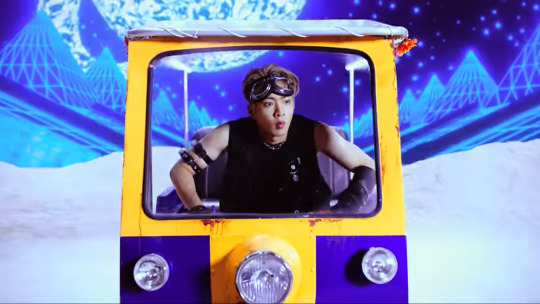
Wyatt rides a tuk-tuk in cyberspace
So, where is Sukhumvit in “Sukhumvit Swimming”? The only thing remotely related to Thailand in the MV seems to be the tuk-tuk that Wyatt drives through a CGI cyberspace landscape. At first glance, even this is jarring—why would one drive a tuk-tuk through cyberspace? The answer is: why not? “Sukhumvit Swimming” insists on mixing the local with the global. The cyberpunk always stays true to their roots even as they dive into popular culture. Cyberspace, in most cyberpunk, is a visual fest where one can look like whatever they want. If one wants to traverse it with a tuk-tuk, so be it. In a way, all the six settings in the MV are Sukhumvit. They are all a bizarre mix of human-nonhuman, past-future, real-unreal, categories that cyberpunk always confuses to question their boundaries. This confusion allows cyberpunk to figure out, in distinct ways, how an individual’s life is embedded in global capital.

These androids are hella creepy. This sequence seems heavily inspired by Westworld, a cyberpunk work set in an amusement park where artificially intelligent android “hosts” gain sentience and rebel against the abuse that the human guests of the park have practiced on the androids for year.
Each setting of the MV evokes Sukhumvit as a tool, and it is what makes “Sukhumvit Swimming” a clever study of cyberpunk. The first setting is Hyojin’s 1920s American railroad. Whether we are to think of the “people” on board with Hyojin as literal androids or grotesquely mechanised human beings, there are disturbingly few differences between androids and people working like clockwork to their schedules in a metropolis. Our cowboy is different from the rest of the occupants on this train; he is not dressed in the stuffy clothes of these robots—he is a (console?) cowboy, a punk, a rebel.

Hyojin as the cowboy.
U, too, seems to be on this train, but he is, well, high. He drinks a bright blue liquid from a glass and things start to swim. With time stopping and MK floating in space, questioning the reality of our disparate, mediate, postmodern existence should not be too difficult for us. In fact, stimulants of various kinds are an integral part of cyberpunk. Apart from their performance-enhancing effects, drugs are always connected to altering/understanding reality much like the technology of the cyberpunk universe.

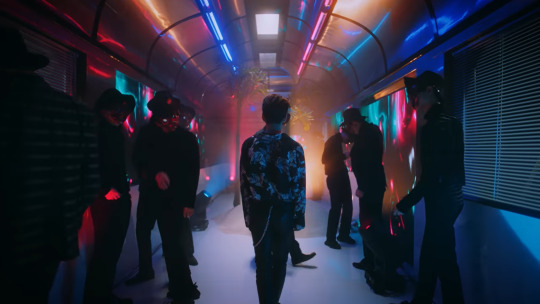
Kids, don’t do drugs.
Is the virtual world, where we are all information, more real than our world, where we are just expressions of biology? Is the train that U is on real? The minute U consumes that glass, “reality” is up for grabs[1].
The second major setting of this MV features J-US in the sunburnt ruins of Greek columns and skyscrapers.
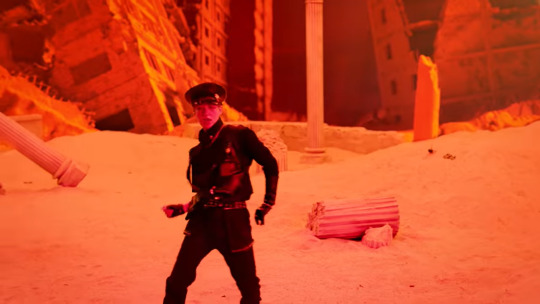
J-US’ suburnt world. Blade Runner 2049 has very similar visuals to this post-apocalyptic world.
This odd, out-of-time combination is another reason why “cyberpunk” jumped to my mind. Cyberpunk likes to juxtapose history with the present times and ask: what is the place of history in a time when technology has skewed our perception of time? The anxiety of technophobes is often that these revered worlds like the cradle of Western Civilisation will be forgotten. The survival of these cultures without context—just stone columns in sunbaked worlds—reminds us of the tyranny of the object. Long after humans are gone (extinct or only alive in a virtual world), these traces of us will be left. Until then, we can only absorb and re-write these monuments into our present alongside the skyscrapers of the capitalist world—much like the pastiche cityscape of Sukhumvit.

E-Tion is on the moon. The moon landing was faked, btw. Or was it?
E-Tion’s moon landing is a particularly strange setting. The others, in one way or another, can be found on earth, but why is E-Tion on the moon? Distance and travel in this MV are unstable concepts. If one can travel through cyberspace in a tuk-tuk, one can definitely grow flowers on the moon. In a patchwork fantasy world (like Sukhumvit), anything is possible. More than that, scale is another notion “Sukhumvit Swimming” is determined to throw in the trash. When virtual worlds are accessible to us through stimulants and technology, the moon is no longer the symbol of extraordinary achievement or emotion (“shoot for the moon,” it is said). Even the moon can be subsumed in the network of capitalism--just ask Elon Musk.
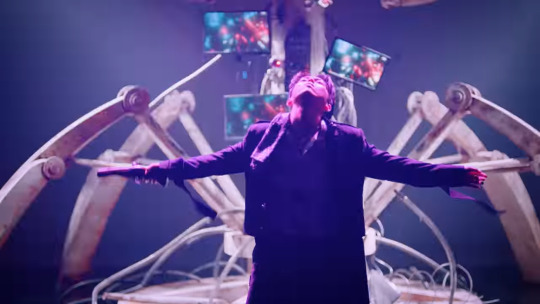
MK really reminds me of the Master here.
The only setting we are now left with is MK’s scenario with the mysterious machine. It could be the machine that is responsible for these strange visions; it certainly looks like the Twelfth Doctor’s time-travelling machine, the TARDIS, from BBC’s Doctor Who. Perhaps it is even one of the machines from The Matrix, that are determined to keep humans as only bio-powered cells for the energy they can provide (bio-powered batteries would not generate enough energy, by the way. That’s one of the flaws in the Wachowskis’ reasoning). Strangely enough, no-one touches the machine; MK disappears from the scene towards the end of the MV, leaving the machine perpetually working. The machine never stops and the dreamers (assuming that there is a particular “real” world) will not wake up—unless, of course, something brings them out of the illusion.
That brings me to the “storyline” of this MV. There is certainly one, mixed within the fantastic shots of this MV. All the members start from different settings but towards the end, they all arrive in the desert that J-US started from. The trigger? Hyojin readies his gun to shoot at J-US in quite a memorable scene:-
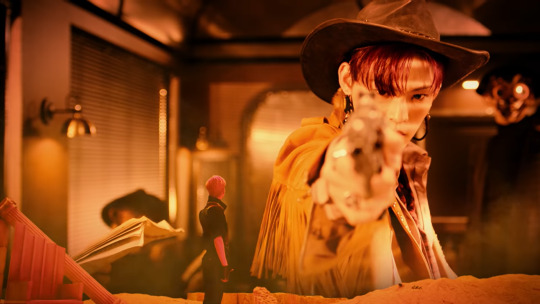
I said this MV likes to mess with scale, didn’t I?
Unexpectedly, Hyojin is the one who is shot. All the members snap out of their “illusions” and end up in the desert with J-US. Everyone is dying or has at least passed out, except J-US who has been in this setting since the beginning. The cyberpunks come together, out of their illusion—or perhaps into one. Time unfreezes and Hyojin is nowhere to be seen on the train. Our cyberpunks have lived and fought in the blink of an eye (or rather, the three-odd minutes that the MV lasts) to disappear with no trace. Fast, suave, and unreal, the cyberpunk is gone once the fight is over. But what have they achieved?

The cyberpunk cityscape is the place for the rebel to explore the strings of corporate domination. In the case of cyberpunk, relations are usually technologies embedded in the logic of capitalism. When ONF creates a temporary Sukhumvit on our screens, they tie together the disparate scenarios of the MV. Now, the hidden relations that linked the moon to a spaghetti Western train and post-apocalyptic world can be read.



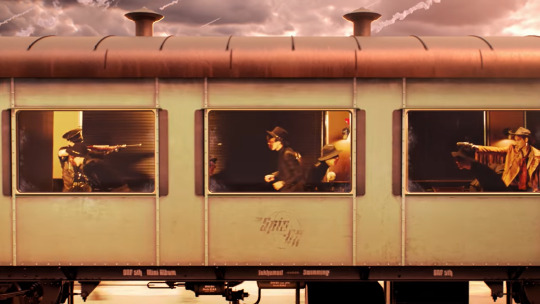
If all the members end up in a dystopian, suntanned terrain, it is because this is where all history leads. “Sukhumvit Swimming” is a slow but certain dive of the world into a spiral of destruction there is no coming back from, a process of the destruction of the world that begins slowly but certainly from the days when human beings began to abuse fossil fuels. The trains, the tuk-tuks, the rockets of “Sukhumvit Swimming” are as much a part of the process as the fireworks that explode in front of E-Tion’s moon.

When the MV ends, Time begins its work again, moving inexorably towards the end. Sukhumvit is a tool to understand how the flows of global capital have isolated humans (and even technology) into our own fantastical worlds, worlds as small as our phone screens, without seeing our connections to the outside world. Our work is to make/find our Sukhumvit, our tool for understanding our place in these networks that seem to mysteriously guide our lives. The cyberpunk has disappeared, but there is someone that still remains: it is you, and your battle has just begun.
[1] Stealing this expression from Cavallaro, Dani. Cyberpunk and Cyberculture: Science Fiction and the Works of William Gibson, pp. 38.
#온앤오프#ONF#스쿰빗스위밍#sukhumvit swimming#sukhumvit#k-pop#kpop#k-pop comeback#spin off#cyberpunk#technology#thailand#bangkok
9 notes
·
View notes
Text
Alert! Chanyeol is on your phone screen!
EXO - SC’s study of Idol Culture and Friendship
Warning: Features Low Quality screen captures because Internet connection struggles.
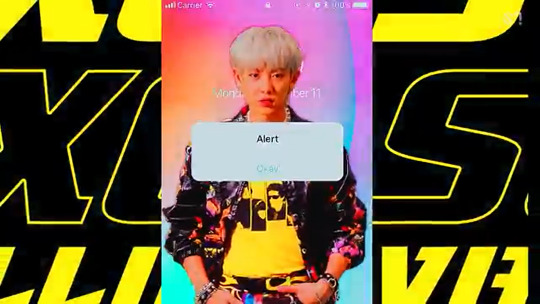
This is, without a doubt, the point where it struck me that EXO-SC’s latest song, “1 Billion Views”, is not the typical flex-song about how popular the artists are, or even another love song cast into the lingo of YouTube views. “1 Billion Views” mixes glitchy phone screens, brightly clothed k-pop idols, and some 4th-wall-breaking to explore our smartphones change our relationships.
youtube
“1 Billion Views” by EXO-SC on YouTube
1 Billion Views is Korean idol group EXO-SC’s first full album. The album has a retro aesthetic, with green matrix backgrounds, tube televisions, and neon skylines featuring in the concept images. The title track of the album is “1 Billion Views”, a groovy, funk house-inspired track with a catchy hook. It has everything that makes a good summer song. The lyrics (at least in the English translation) are fairly straightforward: “I look at you 1 million, 1 billion times, (and you look damn fine)”. You could dedicate this song to your lover. If you are a k-pop fan, you could dedicate it to your favourite idol. If you are a k-pop star, like Sehun and Chanyeol, you could dedicate it to yourself and just bask in the knowledge that your fans have probably fawned over you a million, billion times.
The MV, with its bright neon alleys, chock-full CGI, phone-browsing moments add a different dimension to the entire song. Notifications, alerts, reminders interrupt our view of Sehun and Chanyeol. They conduct live videos and comments flood the screen trying to get the attention of the idols. Sehun and Chanyeol play slot machines made of fan comments as if trying to decide who they should pay attention to—and the fan who gets a response has hit the jackpot.
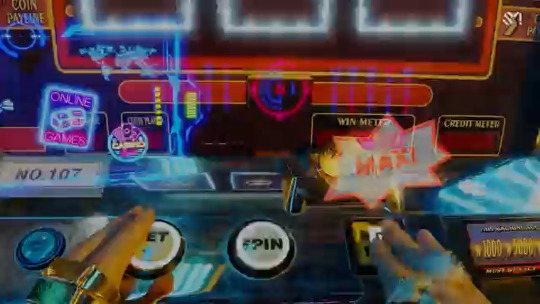

Vocalist Moon’s bridge says, “Play me / Don’t make me feel lonely,”; it’s an invitation to take part in this slot machine game, where the feeling of having immediate interaction at our fingertips takes away our loneliness. Flood the comments, keep tapping the heart button, and the repetition makes it more likely that you will be noticed. So, if your phone says, “Alert! Your favourite idol has started a live,” you must login in to reaffirm your love now. If one listens to the instrumental version of “1 Billion Views”, one can hear the words “There is no past / There is no future” whispered before the hook. Truly, when we must constantly reaffirm our love in the present, the past and the future do not have any meaning. Once the live is over, it is over. You could certainly watch a replay, but the affection you could show your idol when they were live, in the now, can no longer be conveyed.

You aren’t only repeating your questions and your love for your idol every time they go online, you must also re-affirm your relationship with your friends in the same way. Especially in the times of social distancing, our primary means of contact with our friends for many of us is video calls and Instagram updates. We express our dedication to our friends by loyally liking their posts and acknowledging their stories. The repetition of online interaction is the metric of how close someone is with you in real life. Some of us have online friends as well, and as intimacy becomes increasingly defined by the number of times you interact with a person online, the boundaries between virtual and real relationships blur too.
There are also people who have taken to posting pictures and videos of previous vacations, and the more times you feature in these posts, the more you affirm your friendship in the present. We survive the present by simulating our past as a group. If we do not respond to these posts as soon as we receive the notification, the project has failed. A response too late is not only creepy but also useless; nobody cares about your response to a five-day-old post because it has already received its screen time. The more you interact, the more posts you show up in, the realer the moment becomes. If you do not, perhaps it shows that you are alone and friendless. We bring the past and the future together in a virtual, public, online present. We muse over memories several times—if not a million times. In this repetition, there is no past and no future--only now.
No, this is not the end of all human interaction as we know. It is not necessary that we are going to be trapped in our virtual worlds. Human interaction always changes with technology, and these are new ways of establishing human connections. “1 Billion Views” suggests that the standards of idol culture are criss-crossing with our standards for “IRL” interactions. We borrow from different internet cultures to build new ways of adapting technology for our own needs. Although it may seem like we are slaves to the notification alerts of our smartphones, sometimes we need those alerts to lighten up our unchanging, eventless days. Call up your friends repeatedly or fawn over your idols—this is only the beginning and you have all the time in the world.
6 notes
·
View notes
Text
Those posts that are like “people have always been stupid about new technologies – folks used to be afraid of electricity!” kind of get my goat. Like, yeah, folks did used to be afraid of electricity. Because when municipal electrical grids were first being rolled out, safety standards were nonexistent, household wiring was often inadequately insulated, nothing was properly grounded, and people would routinely die from touching a lamp. Context matters!
5K notes
·
View notes
Text
Mothers in Her Private Life (2019)
or Motherhood Pvt Ltd. A Publicly Traded Corporation
Spoilers!
Her Private Life is a 2019 Korean drama based on Kim Sung-yeon’s novel Noona Fan Dot Com, starring Kim Jae-wook and Park Min-Young in the lead roles. The show follows Sung Duk-mi (Park Min-young), the talented and dedicated Curator at Cheum Museum of Art, who has a secret that no-one at her work place must know about—she is a k-pop fangirl and fansite master The Road to Si-an. Trouble starts to brew when Duk-mi’s paths cross with Cheum Museum’s new Director, Ryan Gold (Kim Jae-wook), both as The Road to Si-an as well as in her role as the headstrong curator of the Museum. A rumour that Duk-mi is dating idol Cha Si-an (ONE) further threatens to dissolve the boundaries between Duk-mi’s work and private life.

Image from The Asian Wiki
Her Private Life was my first k-drama, and it took me a while to get to this even though a friend has been asking me to watch them for at least a year now. I decided to watch this show because the premise seemed familiar enough from anime and manga like Ore no Imouto Ga Konnani Kawaii Wake Ga Nai and Kami Nomi zo Shiru Sekai (The World God Only Knows). The show’s initial episodes follow the typical pattern of shows on fan culture: the censure and ridicule fan communities face, the struggle as well as joy of keeping up with one’s favourite music, games, TV shows, what-you-have-it alongside one’s daily life. Her Private Life is an easy-going romantic-comedy with bright production pallets, stunning outfits and make-up for its entire cast, and a wonderful OST list; it reeled in (G)I-DLE for the title track “Help Me” and also features songs by Ha Sung-woon, IN2IT, and Davichi. I did not think the show would go beyond the cute-sy and slightly contrived incidents that bring Duk-mi and Ryan’s together. I am happy to say I was wrong.
While the first half of the show focuses on the will-they-won’t-they angle, the second half picks on a very interesting strand: motherhood. There are a lot of mothers, biological and adopted, in Her Private Life. We see some of them while others are only present in the background, but this fabric of various mothers ties together the different characters in this show. We have Go Young-sook (Duk-mi’s mother), Lee Seon-ju, Editor Nam Se-yeon, Director Eom So-hye, Artist Lee Sol, and Ryan’s adopted mother—who never makes an appearance on the show but is an important part of it nonetheless. All these women have a different relationship with motherhood; they struggle through it in different ways as their male counterparts do not actively participate in child-rearing[1] or the domestic sphere--what is “private” must be managed by the woman. Inept men fail women and also trample the future of children in the process. In Her Private Life, the so-called domestic sphere mixes up with business when women rear children as a community and also become breadwinners. They are left alone to balance responsibilities both the domestic and public spheres, and can only rely on each other to look after their children. By exploring motherhood through the different mothers peppering its story, the show quietly states the feminist maxim “the private is the public” to throw out gendered division of labour.
Young-sook and Seon-ju are “traditional” mothers, and it may seem that there is nothing new about them. While the two women never meet on screen and discuss their lives, they have much in common; they spend much of their time with their children and derive pleasure from motherhood. Despite being married to men who are at least physically present, Young-sook and Seon-ju have to take much of the burden of parenting on their shoulders.

Image from Manga and Anime Maniac
Young-sook is an efficient and loving mother of two, Duk-mi and Duk-su. She also takes Nam Eun-gi and Heo Yun-jae/Ryan Gold, a supposedly abandoned child, under her wing. In the course of the show, she acts as a mother to Kim Hyo-jin, the Museum intern struggling with an insensitive with her own mother, Director Eom So-Hye. Young-sook receives little support from her husband except finances. Being a mother to five children at different points in time, Young-sook is a super-parent. Young-sook’s role as a nourishing caregiver to all these children ensures that they becomes well-adjusted individuals in the course of the show. Her affectionate rearing in the domestic sphere becomes the backbone on which single mothers like Nam Se-yeon can earn their livelihood in the public sphere. She is the glue who binds families together.

Image from Go K-Pop
Seon-ju, like Young-sook, shares a thorny marriage with her husband and practically raises Geon-u on her own. A “modern” mother, insofar she owns and manages a café, Seon-ju is self-sufficient when it comes to money. Her husband, Kim Seung-min is rarely available for the emotional support that Seon-ju wants in her marriage, and he remains busy with his work life. In the beginning of the series, it is only for the sake of her child that she stays in her marriage. Seung-min further alienates Seon-ju when he helps produce a documentary film called “Obsessive Fangirl of the 21st Century”, hurting Seon-ju who is a fangirl herself. Seung-min insists that his work is separate from his family life and thus Seon-ju should not be disheartened by the documentary; work life is separate from private life, a distinction that we can only draw in the case of gendered division of labour. Seung-min even tries to justify his contribution to the documentary by saying that he did it so that he could transfer to a variety show and be able to spend more time with his family. Seon-ju refuses Seung-min’s excuses, Seung-min apologises to Seon-ju for thinking that he could work on a documentary that portrayed fangirls in a negative light while also respecting Seon-ju’s life as a fangirl; their reconciliation only happens when Seung-min lets go of the constructed binary between a public sphere where one works and the private sphere of domestic life.
Editor Nam Se-yeon and Lee Sol are the two career-driven women in the show who raise their children, manage their domestic sphere by “giving them up”. Se-yeon is still single during the events of Her Private Life because few men her age seem to be compatible with “ambitious” women—a gaslight-y way of saying they are intimidated by her success. When Eun-gi was born, Se-yeon was desperate enough to consider leaving him since she could not rely on Eun-gi’s father to support her. Only a woman, Young-sook, steps forward to help Se-yeon in her time of need and allows her to move forward in her career. Women must hold the fort in both the public and the private sphere.

Image from MayRealm
Meanwhile, Lee Sol raises Yun-jae/Ryan on her own even as she toils to make it debut as an artist. Lee Sol loses her son when she is knocked into a coma after a car accident. Although Lee Sol is not able to find her son until she meets him as Director Ryan Gold of Cheum Museum of Art, Lee Sol’s lost son finds love and warmth first in the family of Young-sook and then in the Gold family. The accident damages Lee Sol’s hand enough that she can no longer be an artist and pursue her career. Again, it is Young-sook who initially takes care of Yun-jae. Even though she must later give him up for adoption, Young-sook steps in as a mother to prevent Yun-jae from being traumatically orphaned on the day Lee Sol met with her accident. Young-sook is a kind of a “middle mother” who willingly nurtures Eun-gi and Yun-jae in a way that they can cultivate strong and healthy bonds with their parents and themselves.
Motherhood, however, is not the sole test of these women’s characters or moral sense. In portraying the efforts these women put into all aspects of their life, Her Private Life does not offer any judgement on who is the better mother “and, thus the better woman”. Even though Young-sook is the super-mom, she is also the only mother in the show who loses a child. Her youngest, Duk-su, passes away in a car accident. There was nothing Young-sook did to “deserve” it and nothing she could have done to prevent it. She is not rewarded for being a super-mom, and the other mothers on the show are not censured for choosing to run businesses or pursue a career.
Perhaps the only mother Her Private Life condemns is Eom So-hye, who is not a bad mother but an insensitive person in general. So-hye cares little for her employees at Cheum and often makes life difficult for her daughter, Hyo-jin, even if it comes from a place of trying to prevent Hyo-jin from engaging in sasaeng-like (stalker) obsessive behaviour. Young-sook’s advice to So-Hye is not just advice for becoming a better parent but becoming a better person by listening to the needs of other people. Though So-Hye remains the drama queen character of Her Private Life, by the end of the show she is no longer the obnoxious person who wishes to boss everyone around.
Without introducing an element of “karma” or what-comes-around-goes-around for the different motherhoods—traditional or modern, involved or a little aloof—Her Private Life gives breathing room to motherhood. Since men cannot support them emotional or financially or both, women step outside their houses to take on the roles of breadwinners while balancing the role of caregivers. Women divide roles according to their strength and not their genders, and advance in their careers and raise well-adjusted children without the need for a patriarch to guide them.
[1] We do not know what relationship the Golds share.
2 notes
·
View notes
Text
Entrance: For a Rest
“No One Knows” by Seo Eunkwang from FoRest: Entrance
“I made this song to give hope and strength,” says Seo Eunkwang about “No One Knows” in his VCOOKIE LieV. He wants the lyrics to be relatable to his audience, and it seems to have struck a chord with the fans (MELODY), if Twitter is anything to go by. Eunkwang’s song is about those people who keep quiet about their own suffering and only give strength to others. They keep their deepest fears locked up inside themselves and do not share them because they feel the need to put on a brave front for others. As the song progresses, the singer breaks out of this cocoon of their own making and confronts the flaws in this thinking.
The MV showcases this struggle through various means, and I want to look at the various symbols work in tandem with the lyrics. These images exude calm but simultaneously harbour a deep unrest.
youtube
“No One Knows” by Seo Eunkwang on YouTube
Most of the MV is set in a traditional Korean house nestled in, well, a forest. It looks like a place one may retreat to when looking for peace and a break from daily life. This house itself is one of these so-called symbols, displaying an outward serenity but it is also the space of a quiet conflict that Eunkwang faces alone. Eunkwang wanders this house and observes the scenes around it with thoughtful looks that hide pain inside.
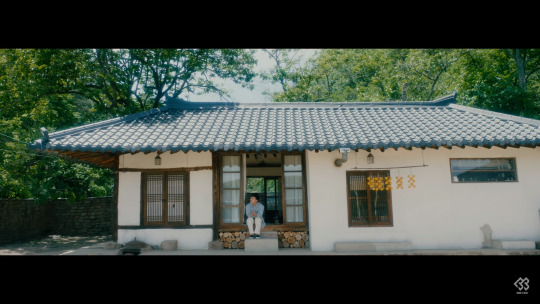
From this introduction, the MV cuts to the small happenings of this house and its surroundings to showcase the song’s conflict.
First, we cut to a rivulet. Although the sound of running water is always calming, this rivulet flows sluggishly, almost sadly on the surface. Underneath its dark surface it may harbour turbulent currents.

The MV also uses images of ants struggling alone. One ant crawls across a tomato (I think), while another stays trapped inside a glass. These ants are separated from their companions and wandering through (what to them will be) vast tracts of land without hope. It is an image of loneliness.


A mosquito repellent coil maybe a harmless household item, but I found it to be the most unsettling image in the MV. These coils burn quietly, releasing poison in their slow simmer to death.


In a song that claims that “no one knows what I feel,” it comes across as a cry for help. A person maybe a useful shoulder to cry on for someone else but be inching towards their own exhaustion at the same time. As the lyrics say next:


The plastic toy that Eunkwang finds in a transparent plastic cover tells the same story. Its smile is plastic—a show for the world. The toy smiles, but it lives alone in a bubble.

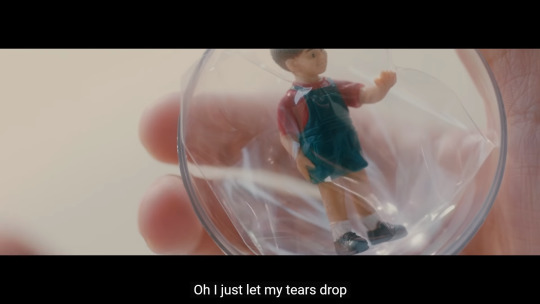
Even as Eunkwang sings about meeting his friends, there is no relief in these meetings. He waits at train stations alone and restless, contemplating his surroundings with the same thoughtful look.

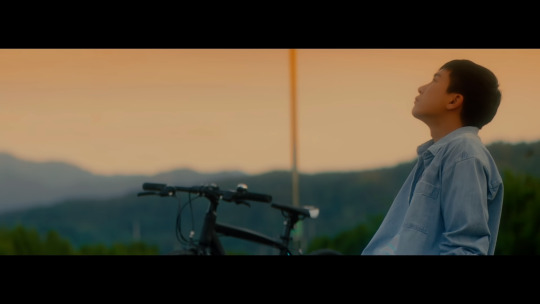
Journeys generally symbolise a change, a transformation, but all we see in this fast fading twilight is a quiet frustration.
At this point, the song and the MV reach a crisis. Until now, Eunkwang sang the refrains “It doesn’t matter whether no one knows I’m hurt” and “No one knows what’s on my mind, no one does” with restraint. He whispered them rather than singing high notes at the top of his voice while he was lost in his own inner world. Once we come back to the house, something changes.

Eunkwang toys with a small plane showpiece a couple of times and seems to derive some form of serenity from it. Planes represent an idea of freedom. We can fly to distant lands and escape with these machines. We can fly. The planes in the MV form a showpiece that allows them to only go around in circles. These planes cannot take us to our dream lands anymore. Those dreams are no longer available for us to chase, or so we think.

Eunkwang stops playing with the showpiece as if something has snapped. The music, too, approaches a crescendo (and Eunkwang proceeds to show off his vocals).

Instead of looking outwards to the fact that no one knows his struggle and finding reflections of it in his surrounding, Eunkwang reflects on his relationship with himself and cries.


It is not only that people do not know what happens inside our minds, but there is a part of us that does not know how to show these emotions or even how deal with them. It is a struggle against ourselves, where we must struggle against this reflex of trapping ourselves inside a harmful mindset. This self is not evil. It is a part of us that, for some reason, thinks that our problems are somehow not worth the attention of others. We are too afraid to dig deep and be vulnerable except when we are alone in our rooms, shielded even from our own sight in the dark night. We have to take off this burden from our shoulders and accept our own feelings at the very least.
The road to recovery is long and slow. We may have to be as slow and vulnerable as a snail in this process, but one cannot rush it.

We finally see this vulnerability in Eunkwang himself. Instead of calmly studying his surroundings, Eunkwang furiously pedals in the next sequence as if he were trying to get away from something.




He was pushing himself physically and mentally, but he now lets exhaustion show as he stops and hangs his head. The camera leaves him alone, as if to finally reflect on his state by himself rather than the expectations of an outsider.



After holding in emotions for so long, we finally reach the boiling point and let it all out.

As the song comes to a calm end, the screen goes blank and Eunkwang sings “Farewell” to that self in the mirror that held him back. Life has returned to normal as Eunkwang cycles calmly through the same landscapes again but:
a) in the opposite direction.

and b) with the beginnings of a genuine smile.


2 notes
·
View notes
Text
I’ve been watching old Bollywood movies and a lot of k-pop.
You know what comes next :)
0 notes
Text
21 lighthearted questions
1] What’s the last thing you did that made you feel proud of yourself?
2] What was your last inner chuckle about?
3] What’s your favourite flower?
4] A thing you accomplished today?
5] What’s the most beautiful word in the English language?
6] Favourite way of dancing?
7] If a rogue managed to unlock access to the secret chamber of your home/lair/mansion, what would they find?
8] What’d be your perfect sleep accommodation?
9] Favourite fruit?
10] If you could grant one wish to another person, who would that be?
11] One thing you like about your physical appearance?
12] One personal trait you like having?
13] What happened the last time you got goose bumps?
14] What’s a movie you feel deserves more love?
15] What’s a song you need people to hear at least once?
16] If you were a dragon what would you horde?
17] What Olympic sport would you love to excel at?
18] What do you think is the worst kind of minor inconvenience?
19] What’s your favourite natural phenomenon?
20] Favourite childhood TV show?
21] Which televised stereotypical high school group would you belong to; jock, cheerleader, goth, band geek, nerd, punk, prep, other?
9K notes
·
View notes
Text
Immobilising Reason
Sleepy Hollow’s (1999) Ichabod Crane (played by Johnny Depp) has been set up for failure. He is a man who believes in reason and the scientific method, so his superiors send off the chemical-analysis fan to Sleepy Hollow. This small village has been beset with a supernatural terror, the Headless Horseman, who is beheading people. There is no way to catch or stop this menace, so the New York Police decide to send Constable Crane to this scene where his reason must stop functioning and turn to the supernatural.
Crane falls very well into this trap. He is, at first, dismissive of the story told by the inhabitants of Sleepy Hollow; there is a person behind this smokescreen and not a ghost. But as he very soon finds out, the Headless Horseman is very real and capable of taking off heads. Crane pursues the murder mystery until the end and puts his superiors’ doubts to rest, but he does it in a surprising manner: standing still. The Ichabod Crane that wants to collect evidence and ride horses for investigation cannot function in this setting because the threat of Sleepy Hollow is not one that can be solved by taking action. Inaction is the modus operandi of this village, and Crane catches on to this fairly fast. In several instances, Crane advises his sidekick, Young Masbeth, and his love-interest Katrina Van Tassel to “stay still” or “do not move”; action brings nothing in the world of the supernatural. One can reverently wait for the supernatural to unfold and nothing more. Crane justifies his inability to do things a number of times. He claims that the chain of reasoning guides him to conclude that Katrina is the culprit behind the crimes. Young Masbeth is horrified by this conclusion, accusing Crane that he is “bewitched by reason”, to which Ichabod replies, “I am beaten down by it!” When the Headless Horseman appears at the climax, Crane does not fight or resist him. He merely takes the head of ghost and throws it into the base of the tree where he originated from—he returns the supernatural to the supernatural. Johnny Depp plays Ichabod Crane in Tim Burton’s adaptation; Depp is known for playing quirky, fidgety characters who are always moving and doing something, but in this case even that bubbly rendition of Depp is rendered useless and motionless.
All of this seems to suggest that there is no agency for the operator of reason, but the supernatural gets to decide their action. A rational man cannot commit a crime because reason will not allow him to do it. The only person who can commit crime, then, is the witch, who does not follow reason. The supernatural is where crime can originate from. At the same time the “man” of reason can only follow a certain, given path; it is magic that allows for agency, creativity. Ichabod Crane is fated to be a detective, rendered mobile in his agency thanks to reason. But Lady Mary Van Tassel and Kristina Van Tassel are free to do what they want.
#sleepy hollow#johnny depp#washington irving#tim burton#horror#supernatural#reason#cristina ricci#agency
3 notes
·
View notes
Text
happy 2,102nd birthday to mark antony! the only reason we know his exact birth date two thousand years later is because after his death the senate officially cursed the day of his birth and we have calendar fragments saying january 14th is a Bad Day due to being antony’s birthday. and i think that’s beautiful
37K notes
·
View notes
Text
Martian Motherhood
The last section of Kim Stanley Robinson’s Red Mars is narrated from Ann Clayborne’s point of view. A prominent geologist of the First Hundred, Ann has always opposed terraforming. She loves Mars the way it is, and she is even pronounced the first Areologist. She hates the plans that Sax comes up with because they will destroy the natural beauty of Mars. At the collapse of the revolution, Ann is also mourning the (presumed) death of her son, Peter. Robinson opts to narrate the crumbling of Mar’s revolution from this point of view, the position of a grieving mother. Mars tries to roll back the terraforming and stand up for itself—to leave Mother Earth behind—but these attempts fail. There are so many ways of life that the people on Mars still derive from Earth. The infrastructure, the literal bubbles of air that the inhabitants live inside, can easily be dismantled from the outside and expose them to the terrors of Mars. It is not possible for them to become true Martians because the minute they expose themselves to the elements, they move towards death. Ann herself tries to commit suicide by trying to expose herself to the Martian cold. To become of the planet, to truly take oneself away from our origins from Mother Earth, is to die.
Mother Earth has a troubled relationship with its children. Many of the First Hundred and the newer migrants manage to survive the destruction of the Martian townships thanks to the Hiroko’s hidden communities. They claim to be the real children of Mars, one of Hiroko’s brood is even named Kasei—Japanese for Mars. Are they somehow more Martian than Ann? Or maybe they are U-topians; they are the people of the No-Place of the Utopia inhabiting the planet in a model that they simply aim to perfect for the Good Place.
It later turns out that Peter is alive and well, and he managed to escape the disastrous fall of the elevator township. Ann is reunited with her child, and that is where the point of view ends. Despite all that has happened, family is re-united. To end with Ann is to remind us of our ties to our bleeding planet. We do not know much about Peter or what relationship he shared with his mother, but we can only imagine that the Ann’s grief for Peter’s supposed death is in some ways similar to Mother Earth’s grief over the death of her progeny on Mars. The geographically-divided politics of Mars is testament to the fact that it is impossible for us to forget Mother Earth. She is always there in the background, witnessing our progress; she is the one who made us. The No-Place of Hiroko’s community can provide us reprieve and hope, but it can never change the bonds that we share with Mother Earth. She might hold us down, but she is our true home no matter what. Escape is impossible, but then escape is not the only way to move forward.
6 notes
·
View notes
Text
The Monster-Citizens of India
Netflix India is back with another anthology of stories, but instead of Lust Stories we now have Ghost Stories. The movie looks like it is well on its way to becoming a “Mixed to Positive” reaction from critics and audience. The technical excellence of the movie is not my concern, even though I must acknowledge the brilliance of these movies. Ghost Stories spins some old tales in new ways and assures me that the Indian genre fiction scenario is moving to a better directed, written, and acted era. Perhaps we will may, in the near future, place the bid to have the names of Indian horror counted alongside enduring classics like The Shining and Shutter.
My concern is the rather perfectly-timed arrival of these stories, particularly story 3: Dibakar Banerjee’s Monster. The story begins with the arrival of an unnamed government clerk in the town of Beesghar (translated “Smalltown”) late at night. The town is empty except for two children—a boy from Beesghar and a slightly older girl from Saughar (translated “Bigtown”). Beesghar is a part of Saughar, but there have always been differences between them since Saughar seems to be economically well-off. In the present, there are no markers of these differences because, as the children ominously tell us, everyone has been eaten. There are cannibalistic zombie-like creatures on the streets of Beesghar that attack you the moment you speak or move in front of them. The only way to stay alive in this situation is staying indoors, eating raw onions, and drinking curdled milk; or, one can decide to join the zombies by eating human flesh. Towards the end, the clerk tries to make it out of Beesghar. This attempt ends with the little girl being eaten by her (former) father and the little boy bullied into eating human flesh. The clerk alone runs away from the monsters and falls into a pit in the ground where he faints. Later, he wakes up to find that the children are gone. A group of people in a Mahindra Jeep find him wildly beating his chest in anguish. They tell him that Beesghar has been abandoned for a month. Whatever happened must have been a figment of imagination. The decrepit state of Beesghar is a result of the actions of the inhabitants, actions that deserved having their home burnt down; Saughar residents did not have anything to do with it.
The a-historical town clash of Beesghar and Saughar somehow captures the complexity of present-day India. The meat-eating contention is not the Hindu-Muslim contention of beef; it is forcibly eating food that makes you a part of the mindless masses. Tanul Thakur of The Wire also noted how the conflict of Beesghar and Saughar becomes a dream for the clerk. He argues that Monster is a story about the movement towards a single culture through social media. There is certainly the suggestion that the more you speak, the more likely it is that the mindless hoards will attack you but Monster is hardly as simple as that. We never have the clerk coherently narrate the events to the outsiders. He does not even speak a word to them because he is so dumbstruck. Even as we see the woman in the car (who looks suspiciously like the behenji the clerk tried to hail in the middle of the story) feed the clerk, he starts to doubt the reality of his experience. What could he possibly tell these completely sane people from Saughar? How could he tell them that he saw people turning into monsters who went blind, who only feasted on fresh human flesh, even if it was one’s own daughter? Family ties no longer mattered in that frenzy to identify who is with us or against us. A history of peace and harmony means nothing in the face of these divisive borders.
The monsters themselves maybe stupid, but we know that the creature orchestrating these attacks is not. The furriest and ugliest of the monsters, the man who started it all by eating a citizen of Beesghar, is a shrewd creature. He easily recognises the fact that the boy and the clerk are not a part of “us”. Instead of eating both of them, the leader presents the boy with a choice: he can either eat the flesh of the girl or join the clerk that the leader intends to feast on. In this way, the leader manages to convert the last citizen of Beesghar into the indistinguishable mindlessness of Saughar. The boy accepts, and the last thinking bastion of Beesghar falls—there will no longer be voices against Saughar. The education of the boy actually comes from Saughar. He tells us that students from Beesghar went to Saughar to study because there was no opportunity to study in the small town. When the children of Beesghar make it to Saughar to study, the citizens of Saughar look on them as intruders. They do not value what the children of Beesghar bring with them—real world experience (which is perhaps why the boy survives as long as he does). The Beesghar kids, too, must become like the children of Saughar. The Big Town refuses to acknowledge that Small Town could have anything to offer, wiping out the traditions of Small Town. They are literally wiping out the only voice that could participate in the progress of Beesghar—an educated boy who can navigate the town’s traps and survive. They are wiping out the only voice that could say anything about the life in Beesghar before the disaster and tell us how the events took place that led to the downfall of Beesghar. Without the boy, the town may as well have been destroyed by ghosts and not monsters.
Uncertainty and an incommunicable terror define the lens that Monster offers us. The strength of the Saughar residents is such that they will not allow Beesghar to own its story. As soon as the clerk leaves Beesghar and steps into the vehicle of the Saughar residents, he is made to doubt the veracity of his own experience. No matter the remains of the carnage that run through Beesghar; since no one from Saughar is willing to accept the account of the clerk (or perhaps the earlier Beesghar residents), it means that it simply did not take place. After the attacks on JNU protestors on Sunday night, a Delhi Police member told us that no violent incidents had occurred. Or perhaps, the Saughar residents are right, and the Beesghar residents really did take actions that deserved fire and riots. That way, it does not matter which side ate which side first. It does not matter if it were ABVP students or JNUSU students who were beat up; it mattered that whoever said anything different should be put down. It does not matter whether the face on the TV is the face of the President of JNUSU or that of an ABVP student—even when we very well know that it is the face of Aishe Ghosh. The masked miscreants somehow entered the campus of a highly regarded educational institute and attacked several students and then left the campus like ghosts. They cannot be monsters because no one can vouch for their presence despite the several videos on the Internet. What this tells us is that our experience and our word means nothing in this world. The veracity of our experience holds no value if residents of Saughar do not verify them.
The last bastion, as I mentioned earlier, of Beesghar was the little boy, an unnamed student. He was the only one who stood between Beesghar and oblivion. Once the student is silenced from opposition, there is nothing that allows the employed adult, the clerk, to remember his own fear and trauma. Saughar is sovereign in deciding who is a part of us and who is the enemy.
Who is a monster and on what basis? Who is anti-national and on what basis? Who is a citizen and on what basis?
#caa#caa protest#netflix#monster#citizen amendment bill#citizen#nrc#nrccaa#jnu attack#social media#fake news#india#ghost stories#dibakar banerjee#delhi
1 note
·
View note
Text
Today at the protest in Delhi, the police attacked and detained even the medical volunteers and attempted to seize the ambulance. The police also tried to drag and beat up the nurses and the driver from inside the van.
The doctors and nurses all belong to the Progressive Medicos and Scientists Forum (PMSF) who have been working tirelessly to provide free and immediate first aid and medical care to the protestors. The Indian Government along with Delhi police is clearly violating the Article 19 of the First Geneva Convention.
Please spread the word. The situation isn't getting any better. Uttar Pradesh, another state which is burning. Lots of protestors are missing, 18 have been confirmed dead. News of massive violence against Muslims have been coming out in bits and pieces as internet has been shut down there as well.
107 notes
·
View notes
Text
What happens after Evangelion? Posthumanity in 新世紀エヴァンゲリオン (Neon Genesis Evangelion)
I finally watched (and subsequently re-watched) the classic (and highly controversial anime) Neon Genesis Evangelion, thanks to Netflix’s partial acquisition of the rights to the show—they somehow forgot “Fly Me to the Moon”[1]. Evangelion is an anime about a lot of themes—too many, thanks to Hideaki Anno’s dodgy responses regarding its interpretations. Alienation and depression are at the center of it all. Countless articles will tell you that Anno was suffering from depression while working on Evangelion. Further, Japan had recently faced terrorist attacks in Tokyo, as well as a series of devastating earthquakes. In the face of such tragedies, Evangelion asks, what will become of us in the future? In a world where lives are arbitrarily lost, where we have no direction to go towards, how can humanity itself continue?
These are some of the bigger questions that Evangelion asks, and they connect to the more intimate, the more human questions it poses as well. How can two human beings form any connection when disasters like the Second Impact occur? The English title of the fourth episode of the series is “Hedgehog’s Dilemma”. Philosopher Arthur Schopenhauer coined this term to express the complexity of human relationships; moving closer together—physically or mentally—means that we will hurt each other. And yet, this proximity is what we humans crave the most. How do we reconcile these conflicting desires and keep moving on in the face of tragedy? For many of us, these thoughts may not result from Second-Impact-scale disasters, but personal tragedies—the death of loved ones, or even the break-up of friendships or relationships. These feelings seem unconnected to the future of humanity, but as the series repeatedly emphasizes, the two are linked. Evangelion asks: how do we face tomorrow. In my essay, I propose that there multiple ways that Evangelion answers these questions, and all of them are linked to the notion of posthumanity.
Before I get into Evangelion we must clarify what I mean by “posthuman”. An umbrella-term, “posthuman” is literally what comes after humanity. It is the posthuman who must adapt to the new world that is altered by climate change, nuclear wars, alien life contact, and endless numbers of (not entirely) science-fictional scenarios. Bio-technological invasion of the human body alters the limits of a human being, extending us into our electronic environments, interfacing us with machines and artificial intelligence. This is a kind of posthumanity, often leaning towards calling the current human being a “cyborg” (in Donna Haraway’s term). A central aspect of posthumanity tends to be the displacement of the “rational thinking machine” of the Renaissance humanist. “Man” is no longer the measure of all things. The posthuman is as much an animal as any, and no longer claims a moral stature higher than its fellow earth inhabitants. It suggests an equality with everything, especially if we look at vitalist materialist Rose Braidotti’s stance in her book The Posthuman. These are the broad notions of the posthuman that I will work with for this essay.
The people in Evangelion are, in at least the bio-technological sense, posthuman. This is especially true for the three EVA pilots, who meld with their EVA Units. However, that is not enough to survive in this world. Humans are no longer allowed their aspirations, displaced as they are by repeated Angel attacks. They still do not connect with their environments—the futuristic landscapes of Tokyo-3 little more than blast shelters. Animals do not even survive in this world. There is something missing in even the humanity of the Evangelion human beings, and all characters can feel that. That is why there is a thrust to the posthuman in the show with the 人類補完成計画, translated as the Human Instrumentality Project, comes into play. 「人類方完成計画」means different things to different people and organizations—is not surprising, considering this is Evangelion. I see three major interpretations of this phrase, and these are the posthumanities of Evangelion, the humanities after the Evangelion series. These are the posthumanities of Seele, Ikari Gendō, and Ikari Shinji.
Let us start with Seele. “To return humanity to its original form”—this is the posthumanity of Seele. All individuality must be extinguished, and we must return to the primal forms of Lilith and Adam. Why Lilith? This is where my knowledge of the Christian tradition fails. As far as I know, Lilith was Adam’s first “companion”, but she never lay with him. Instead, she gave birth to all the monsters of the world. Often, she has been thought of as a witch. If you want an instance of Lilith close to the world, Jean E. Graham’s paper “Women, Sex, and Power: Circe and Lilith in Narnia” compares the White Witch of Narnia to Lilith. In fact, she is explicitly noted to be a descendant of Lilith. This is speculation, but it seems that we are all, then, descendants of Lilith. Not even those of Adam and Eve, we are irredeemable monsters, unless we go back to the form that bore us, and resume the innocence of the formless. This needs the destruction of the human, and in some ways, this is the end that Ayanami Rei almost leads us to.
Ikari Gendō’s posthumanity is a rogue form of Seele’s plan, insofar as is it wishes to bring together all the living and the dead. The show repeatedly tells us that Ayanami Rei is somehow connected to Ikari Yui, Ikari Gendō’s deceased wife. Most people seem to find this form of posthumanism twisted and somehow fundamentally wrong. Akagi Naoko found it disturbing enough to find Yui still shadowing her that she committed suicide.
Finally, we have the posthumanism of Ikari Shinji. This is how I read the last two episodes of Evangelion, the two episodes that make the least sense in an anime where few things make sense. Over the two episodes, the EVA pilots and other NERV personnel face the monsters that have haunted them throughout their lives and try to overcome them. Shinji’s fear is the fear of intimacy, of becoming close to people. He does not know how to open himself up without getting hurt, primarily because his father never showed him any warmth even after his mother gave herself up to EVA – 01. It is the Hedgehog’s Dilemma all over again. The primarily-teenage audience of Evangelion possibly relates the difficulties that Shinji faces, the inability to somehow “let loose” and connect with people freely. How can one do that when it is so easy to not only hurt others but also hurt oneself? This is what stops Shinji often taking decisive action and stops him from fully realizing himself.
The purpose of the last two Evangelion episodes is to show us how Shinji admits that he has been drawing walls in the way he imagines the world to be. In the alternative world that he dreams of, he acts the same way as his classmates—a carefree, horny, uninhibited, Japanese teenage male. It is just an altered version of a scene we have already witnessed before. It is important that this world is not radically different from his own world. The people are the same—his classmates and Misato still make the experiences of this world. If it can be done in that imaginary world, why not in this world? Shinji realizes that the world he has been looking for does not need to be an LCL-fuelled dream, but a world that he can inhabit. When Shinji rejects the dream world that Lilith-Rei gives him, Shinji accepts the difficulty of human existence. He accepts the borders that characterize the individual human and yet also looks to the possibility of moving beyond our borders and bonding with other people. The “congratulations” sequence in the original ending and the final scene of the 1997 movie (where he almost strangles Asuka), both accept the fact that people are always distinct, but there is no reason why we cannot connect with each other.
The show then inevitably puts its weight behind the last form of “perfection” or 「完成」(Kansei). This is how human realization should function. The show not only addresses teenage anxieties through this, but its rejection of other forms of perfection is important too. It rejects forms of human perfection that try to take us into some primordial past or try to erase all our distinctions. The erosion of borders, the assertion that we are all the same is, is as threatening as the assertion that some shadowy organization that does not even live among us can decide who is or is not a part of a community. Evangelion is prescient in the fact that not only does it see the creation of rigid borders as a problem, but it also sees that the complete dismissal of borders is not a solution either. I would like to think that it gives us tools to think about the problems of borders that we face in many regions of the world—whether it is the wars in the Middle East, the anti-immigrant agendas of Trump’s America and Modi’s India, the slowly digesting monster that is the PRC in Hong Kong, or even the xenophobia that countries like Korea and Japan still struggle with. Every individual must revaluate themselves before we blindly forge on this path that we call “humanity”. Maybe we all need to pause for a few days and watch Neon Genesis Evangelion before we create the cataclysm of the Second Impact.
[1] Before pointing out that Netflix’s dubbing and subbing has horribly altered the anime and therefore Evangelion has lost its essence, please note that I know Japanese. You can find that on my LinkedIn Page. Of course, I haven’t linked that anywhere on Tumblr, so don’t look for it.
1 note
·
View note
Text
↖ this Tumblr user loves Daenerys Stormborn of House Targaryen, the First of Her Name, Queen of the Andals and the First Men, Protector of the Seven Kingdoms, the Mother of Dragons, the Khaleesi of the Great Grass Sea, the Unburnt, the Breaker of Chains.
3K notes
·
View notes

